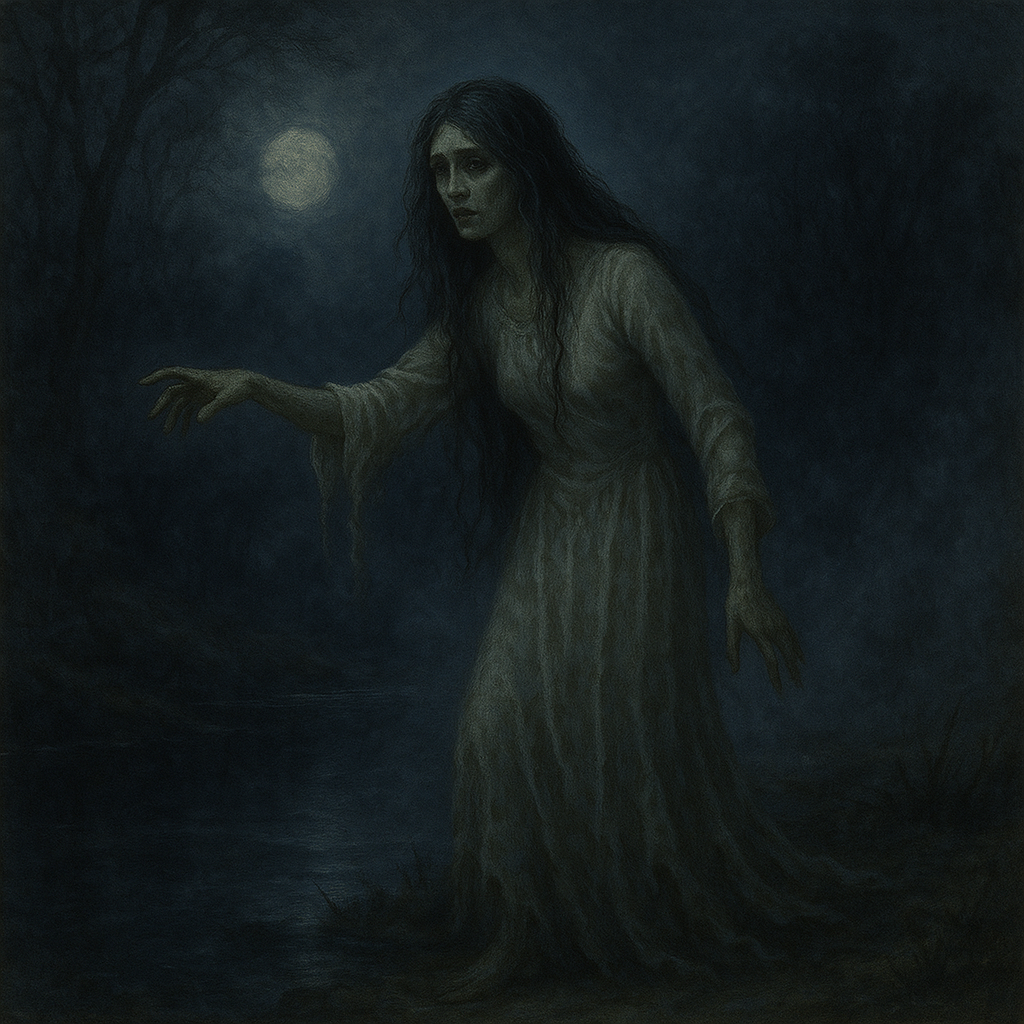
La Llorona - The Weeping Woman
Share
La Llorona: The Cry That Echoes Through Generations
There’s a sound that chills the spine more than any scream. It’s softer—almost mournful. A distant weeping, carried on the wind, echoing through trees and over water.
If you’ve ever heard it near a river late at night… you might have just crossed paths with La Llorona.
To some, she’s a ghost.
To others, she’s a warning.
To many, she’s a story passed down around kitchen tables and whispered to restless children in the dark.
But for those who claim to have seen her—draped in white, eyes hollow with grief—she’s terrifyingly real.
The Woman Behind the Wail
Her name means “The Weeping Woman.” And her story, like the woman herself, refuses to stay buried.
In most versions, La Llorona was once a woman named María—beautiful, proud, and admired by all who knew her. She fell in love with a wealthy man, perhaps a nobleman or a soldier, and bore him two children. But time, as it tends to do, wore down the shine of their love. He began to drift—first in affection, then in presence. Eventually, he left her for another woman, someone younger, richer, or simply less tied to a past he wanted to forget.
What happened next splits between variations, but the end is always the same.
In a moment of heartbreak and rage, María drowned her children in a river.
The grief hit her instantly—an avalanche of regret. She searched, screamed, dove into the water, but it was too late. Some say she let the current take her too. Others say she wandered the riverbanks until her body gave out.
But death didn’t free her.
Instead, it cursed her.
The Curse of La Llorona
Now, she roams the waterways of the world, caught between worlds, her soul forever broken.
She weeps. She wanders. She searches.
And if you’re near a river at night and hear someone crying out, “¡Ay, mis hijos!” (Oh, my children!)—you’d best run. Some say she mistakes travelers for her lost children. Others say she punishes anyone who dares walk the same path of recklessness she once did.
In parts of Mexico and the American Southwest, parents still use her name to keep their kids in line.
“Don’t go near the river after dark… or La Llorona will take you.”
She’s not just a story.
She’s a presence.

Where Fact Meets Folklore
It’s tempting to treat La Llorona as nothing more than a ghost story—another campfire scare, like Bloody Mary or the Hook Man. But she’s more than that. Her tale stretches back centuries, rooted in both indigenous legend and colonial trauma.
Some say she is a reimagining of La Malinche, the Nahua woman who acted as interpreter and companion to Hernán Cortés. Betrayed by the Spanish and vilified by history, she too was a mother caught between love and destruction.
Others believe the story predates the Spanish entirely—an ancient warning wrapped in spiritual symbolism. Water, after all, is sacred in many Mesoamerican traditions: a source of life and death, a mirror of human emotion, a portal between worlds.
La Llorona, then, is not just a ghost.
She’s a cultural scar.
A symbol of mourning, motherhood, betrayal, and consequence.
Modern Sightings & Unshakable Belief
Despite being centuries old, the legend hasn’t lost its edge. Reports still trickle in: a woman in white walking along irrigation ditches in New Mexico, a weeping figure spotted near the Los Angeles River, even unsettling audio caught on night vision cams near rural canals in Texas.
The sightings all share similar details:
- A woman in a flowing white gown, hair wet and tangled
- A voice crying out in anguish, seemingly everywhere and nowhere-
- Cold air, flickering lights, an overwhelming feeling of sorrow
Whether you're a true believer or a hardened skeptic, something about these stories sticks. They're not easily dismissed, not when told by someone who swears they saw her. Not when told by a friend of a cousin who knows someone who vanished near a creek bed.
And maybe that's the scariest part.
Not that she’s real…
But that enough people believe she is.
Why We Still Tell Her Story
La Llorona endures because her pain feels familiar. Who hasn’t known loss? Who hasn’t made a choice they can’t take back?
Her legend is a mirror, showing us the parts of ourselves we try to bury: guilt, grief, rage, heartbreak. She forces us to confront the idea that sometimes the scariest monsters are born from ordinary people, pushed too far.
We keep her alive because, deep down, we know there’s a La Llorona in every culture. Every town has a haunted woman with unfinished business. A ghost who loved too deeply, hurt too much, and now lingers in the places where the living and dead overlap.
Final Warning
So if you find yourself near water at night—alone, maybe a little drunk, maybe just curious—and you hear a voice on the wind, crying softly…
Don’t answer.
Don’t look.
And whatever you do, don’t follow the sound.
Because once you see her, you don’t forget her.
And some say she never forgets you either.
